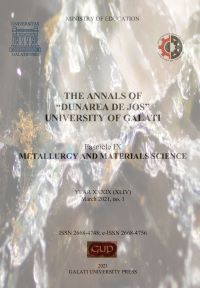Green Synthesis of Metallic Nanoparticles, Phytochemical Compounds and Antioxidant Activity Using Two Types of Algae Plants
Abstract
Scientific studies have demonstrated that the vegetable material extracts act as potential precursors for the synthesis of nanomaterial using eco-friendly ways. Because the plant extracts contain various secondary metabolites, they act as reducing and stabilizing agents for the bioreduction reaction for synthesis of novel metallic nanoparticles.
Herein, we describe the characteristics of different algae types, from different locations (Belgium and South Correa). Algae have important components, like chlorophyll and other plant pigments, omega-3 fatty acids and essential elements. Also, it has been demonstrated that algae provide a rich source of natural bioactive compounds with antibacterial and antioxidant properties. Another important aspect is the fact that algae represent a good wastewater treatment. In addition to the economic aspect, algae biomass is a source of biodiesel and offers an efficient way for nutrient consumption and provides aerobic bacteria with oxygen through photosynthesis. It is a low-cost technique for the removal of phosphorus, nitrogen and pathogens. We first characterized and compared quantitatively (polyphenols, flavonoids) and qualitatively (carbohydrates, alkaloids) the properties of two algae types extracts (green algae - Enteromorpha spp. and brown ones - Hizikia fusiforme). We then obtained and characterized the gold nanoparticles, formed using HAuCl4 (10-3 M) and algae sample extracts. The algae extracts, the green method for obtaining metallic nanoparticles (AuNP) and the nanoparticles investigated by UV-Vis spectroscopy, optical microscopy and SEM technique are shown in this research.
Downloads
References
[2]. Kulkarni N., Uday Muddapur, Biosynthesis of Metal Nanoparticles: A Review, Journal of Nanotechnology, p. 1-8, 2014.
[3]. Thomas J. Joseph Prakash, Sowmiya K., A review on nanotechnology and plant mediated metal nanoparticles and its applications, 8, 6, 20 pp, 2020.
[4]. Kuppusamy P., et al., Biosynthesis of metallic nanoparticles using plant derivatives and their new avenues in pharmacological applications – An updated report, Saudi Pharmaceutical Journal: SPJ 24, p. 473-484, 2016.
[5]. Palanco Marta Espina et al., Templated green synthesis of plasmonic silver nanoparticles in onion epidermal cells suitable for surface-enhanced Raman and hyper-Raman scattering, Beilstein Journal of Nanotechnology 7, p. 834-840, 2016.
[6]. Mehta S. K., Gaur J., Use of algae for removing heavy metal ions from Wastewater: Progress and Prospects, Critical Reviews in Biotechnology 25, p. 113-152, 2005.
[7]. Nair B., Pradeep T., Coalescence of Nanoclusters and Formation of Submicron Crystallites Assisted by Lactobacillus Strains, Crystal Growth & Design 2, p. 293-298, 2002.
[8]. Gardea-Torresdey J. et al., Formation and Growth of Au Nanoparticles inside Live Alfalfa Plants, Nano Letters 2, p. 397-401, 2002.
[9]. Armendariz V. et al., The extraction of gold nanoparticles from oat and wheat biomasses using sodium citrate and cetyltrimethylammonium bromide, studied by x-ray absorption spectroscopy, high-resolution transmission electron microscopy, and UV-visible spectroscopy, Nanotechnology 20, 10, 105607, 2009.
[10]. Ting Y. et al., Gold uptake by Chlorella vulgaris, Journal of Applied Phycology 7, p. 97-100, 2004.
[11]. Singaravelu G. et al., A novel extracellular synthesis of monodisperse gold nanoparticles using marine alga, Sargassum wightii Greville, Colloids and surfaces. B, Biointerfaces 57, 1, p. 97-101, 2007.
[12]. Lengke M. et al., Morphology of gold nanoparticles synthesized by filamentous cyanobacteria from gold(I)-thiosulfate and gold(III)--chloride complexes, Langmuir: the ACS journal of surfaces and colloids 22, 6, 2780-7, 2006.
[13]. Lengke M. et al., Mechanisms of gold bioaccumulation by filamentous cyanobacteria from gold(III)-chloride complex, Environmental science & technology 40, 20, 6304-9, 2006.
[14]. Chakraborty N. et al., Biorecovery of gold using cyanobacteria and an eukaryotic alga with special reference to nanogold formation - a novel phenomenon, Journal of Applied, Phycology 21, p. 145-152, 2009.
[15]. Parial D. et al., Gold nanorod production by cyanobacteria – a green chemistry approach, Journal of Applied Phycology 24, p. 55-60, 2012.
[16]. Parial D. et al., Screening of different algae for green synthesis of gold nanoparticles, European Journal of Phycology 47, p. 22-29, 2012.
[17]. Santhoshkumar J., Rajeshkumar S., Kumar S. V., Phytoassisted synthesis, characterization and applications of gold nanoparticles-a review, Biochem Biophy 11, p. 46-57, 2017.
[18]. Deepak P. et. al., Structural characterization and evaluation of mosquito-larvicidal property of silver nanoparticles synthesized from the seaweed, Turbinaria ornata (Turner) J. Agardh 1848, Artif. Cells Nanomed Biotech 45, 5, p. 990-998, 2017.
[19]. Ramkumar V. S. et. al., Synthesis of platinum nanoparticles using seaweed Padina gymnospora and their catalytic activity as PVP/PtNPs nanocomposite towards biological applications, Biomed Pharmacother 92, p. 479-490, 2017.
[20]. Abdel-Raouf N. et al., Green biosynthesis of gold nanoparticles using Galaxaura elongata and characterization of their antibacterial activity, Arabian Journal of Chemistry 10, 2, S3029-S3039, 2017.
[21]. Senthil Kumar P. et al., Evaluation of alpha-amylase and alpha-glucosidase inhibitory properties of selected seaweeds from Gulf of Mannar, Int Res J Pharma 3, p. 128-130, 2011.
[22]. Senthilkumar P. et al., Facile green synthesis of gold nanoparticles from marine algae Gelidiella acerosa and evaluation of its biological Potential, SN Applied Sciences 1, p. 1-12, 2019.
[23]. Mehta S. K., Gaur J. P., Use of Algae for Removing Heavy Metal Ions From Wastewater: Progress and Prospects, Critical Reviews in Biotechnology, 25, p. 113-152, 2005.
[24]. Arumugam N. et al., Treatment of Wastewater Using Seaweed: A Review, Int. J. Environ. Res. Public Health 15, 2851, 19 p, 2018.
[25]. Şuică-Bunghez I. R. et al., Antioxidant activity and phytochemical compounds of snake fruit (Salacca Zalacca), IOP Conf. Series: Materials Science and Engineering, 133, 2016.
[26]. Şuică-Bunghez, Ioana-Raluca et al., Characterization of antioxidant activity and phytochemical compounds, metal nanoparticles obtained by Sideritis Scardica extracts”, Rev. Roum. Chim., 62, 6-7, p. 545-552, 2017.
[27]. Sulaiman C. T., Balachandran I., Total Phenolics and Total Flavonoids in Selected Indian Medicinal Plants, Indian Journal of Pharmaceutical Sciences, 258:260, 2012.
[28]. ***, International Standard ISO 14502-1:2005, Determination of substances characteristic of green and black tea - Part 1: Content of total polyphenols in tea - Colorimetric method using Folin-Ciocalteu reagent.
[29]. Makarska-Bialokoz M., Kaczor A., Computational Analysis of Chlorophyll Structure and UV-Vis Spectra: A Student Research Project on the Spectroscopy of Natural Complexes, Spectroscopy Letters, 47, p. 147-152, 2014.



